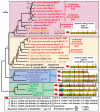Independent evolution of striated muscles in cnidarians and bilaterians
- PMID: 22763458
- PMCID: PMC3398149
- DOI: 10.1038/nature11180
Independent evolution of striated muscles in cnidarians and bilaterians
Abstract
Striated muscles are present in bilaterian animals (for example, vertebrates, insects and annelids) and some non-bilaterian eumetazoans (that is, cnidarians and ctenophores). The considerable ultrastructural similarity of striated muscles between these animal groups is thought to reflect a common evolutionary origin. Here we show that a muscle protein core set, including a type II myosin heavy chain (MyHC) motor protein characteristic of striated muscles in vertebrates, was already present in unicellular organisms before the origin of multicellular animals. Furthermore, 'striated muscle' and 'non-muscle' myhc orthologues are expressed differentially in two sponges, compatible with a functional diversification before the origin of true muscles and the subsequent use of striated muscle MyHC in fast-contracting smooth and striated muscle. Cnidarians and ctenophores possess striated muscle myhc orthologues but lack crucial components of bilaterian striated muscles, such as genes that code for titin and the troponin complex, suggesting the convergent evolution of striated muscles. Consistently, jellyfish orthologues of a shared set of bilaterian Z-disc proteins are not associated with striated muscles, but are instead expressed elsewhere or ubiquitously. The independent evolution of eumetazoan striated muscles through the addition of new proteins to a pre-existing, ancestral contractile apparatus may serve as a model for the evolution of complex animal cell types.
Figures




Comment in
-
Evolutionary biology: Muscle's dual origins.Nature. 2012 Jul 11;487(7406):181-2. doi: 10.1038/487181a. Nature. 2012. PMID: 22785312 No abstract available.
Similar articles
-
Evolution of striated muscle: jellyfish and the origin of triploblasty.Dev Biol. 2005 Jun 1;282(1):14-26. doi: 10.1016/j.ydbio.2005.03.032. Dev Biol. 2005. PMID: 15936326 Review.
-
Smooth muscle-like Ca2+-regulation of actin-myosin interaction in adult jellyfish striated muscle.Sci Rep. 2018 May 17;8(1):7776. doi: 10.1038/s41598-018-24817-x. Sci Rep. 2018. PMID: 29773804 Free PMC article.
-
Independent specialisation of myosin II paralogues in muscle vs. non-muscle functions during early animal evolution: a ctenophore perspective.BMC Evol Biol. 2012 Jul 2;12:107. doi: 10.1186/1471-2148-12-107. BMC Evol Biol. 2012. PMID: 22747595 Free PMC article.
-
Colonial origin for Emetazoa: major morphological transitions and the origin of bilaterian complexity.J Morphol. 2000 Jan;243(1):35-74. doi: 10.1002/(SICI)1097-4687(200001)243:1<35::AID-JMOR3>3.0.CO;2-#. J Morphol. 2000. PMID: 10629096 Review.
-
Shared gene structures and clusters of mutually exclusive spliced exons within the metazoan muscle myosin heavy chain genes.PLoS One. 2014 Feb 3;9(2):e88111. doi: 10.1371/journal.pone.0088111. eCollection 2014. PLoS One. 2014. PMID: 24498429 Free PMC article.
Cited by
-
Structural basis of the relaxed state of a Ca2+-regulated myosin filament and its evolutionary implications.Proc Natl Acad Sci U S A. 2013 May 21;110(21):8561-6. doi: 10.1073/pnas.1218462110. Epub 2013 May 6. Proc Natl Acad Sci U S A. 2013. PMID: 23650385 Free PMC article.
-
A Comprehensive Analysis of Fibrillar Collagens in Lamprey Suggests a Conserved Role in Vertebrate Musculoskeletal Evolution.Front Cell Dev Biol. 2022 Feb 15;10:809979. doi: 10.3389/fcell.2022.809979. eCollection 2022. Front Cell Dev Biol. 2022. PMID: 35242758 Free PMC article.
-
Evolution of the N-Terminal Regulation of Cardiac Troponin I for Heart Function of Tetrapods: Lungfish Presents an Example of the Emergence of Novel Submolecular Structure to Lead the Capacity of Adaptation.J Mol Evol. 2022 Feb;90(1):30-43. doi: 10.1007/s00239-021-10039-9. Epub 2021 Dec 29. J Mol Evol. 2022. PMID: 34966949 Free PMC article.
-
A new flow-regulating cell type in the Demosponge Tethya wilhelma - functional cellular anatomy of a leuconoid canal system.PLoS One. 2014 Nov 19;9(11):e113153. doi: 10.1371/journal.pone.0113153. eCollection 2014. PLoS One. 2014. PMID: 25409176 Free PMC article.
-
Nutrient Distribution and Absorption in the Colonial Hydroid Podocoryna carnea Is Sequentially Diffusive and Directional.PLoS One. 2015 Sep 11;10(9):e0136814. doi: 10.1371/journal.pone.0136814. eCollection 2015. PLoS One. 2015. PMID: 26359660 Free PMC article.
References
-
- Seipel K, Schmid V. Evolution of striated muscle: Jellyfish and the origin of triploblasty. Dev Biol. 2005;282:14–26. - PubMed
-
- Schuchert P, Reber-Müller S, Schmid V. Life stage specific expression of a myosin heavy chain in the hydrozoan Podocoryne carnea. Differentiation. 1993;54:11–18. - PubMed
-
- Chapman DM, Muscatine L. In: Coelenterate Biology. Lenhoff HM, editor. Academic Press; New York, San Francisco, London: 1974.
-
- Burton PM. Inisghts from diploblasts; the evolution of mesoderm and muscle. J Exp Zool (Mol Dev Evol) 2007;308B:1–10. - PubMed
-
- Schmidt-Rhaesa A. The evolution of organ systems. Edn. 1 Oxford University Press; 2007.
Supplementary References
-
- Farah CS, Reinach FC. The troponin complex and regulation of muscle contraction. Faseb J. 1995;9:755–767. - PubMed
-
- Somlyo AP, Somlyo AV. Ca2+ sensitivity of smooth muscle and nonmuscle myosin II: modulated by G proteins, kinases, and myosin phosphatase. Physiol Rev. 2003;83:1325–1358. - PubMed
-
- Nickel M, Donath T, Schweikert M, Beckmann F. Functional morphology of Tethya species (Porifera): 1. Quantitative 3D-analysis of Tethya wilhelma by synchrotron radiation based X-ray microtomography. Zoomorphology. 2006;125:209–223.
-
- Leys SP, Degnan BM. Embryogenesis and metamorphosis in a haplosclerid demosponge: gastrulation and transdifferentiation of larval ciliated cells to choanocytes. Invertebrate Biology. 2002;121:171–189.
Publication types
MeSH terms
Substances
Grants and funding
LinkOut - more resources
Full Text Sources

